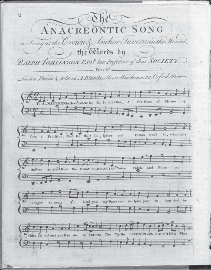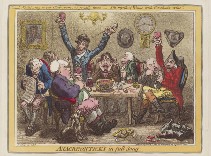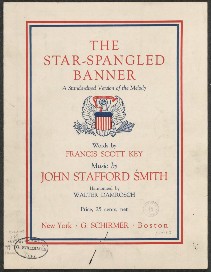9.3: United States of America- “The Star-Spangled Banner”
- Page ID
- 90729
United States of America: “The Star-Spangled Banner”
As is the case with almost every national anthem, the words and the tune to “The Star-Spangled Banner”1 were created by different people at different times. The tune is several decades older than the text, but our story will begin with the famous poem by Francis Scott Key (1779–1843). During the War of 1812, Key travelled with a delegation to the British flagship HMS Tonnant to negotiate a prisoner exchange. Although Key and his compatriots were successful in their mission, they were held captive after overhearing British officers plan an attack on the city of Baltimore. Key subsequently witnessed the nighttime battle from aboard a British ship. Famously, he knew that the American forces had emerged victorious when he saw their flag flying over Fort McHenry in the morning light on September 14, 1814. Key began his poem onboard the ship and finished it shortly after his release from captivity. The text of its earliest surviving draft appears below, transcribed from his handwritten manuscript.
|
“The Star-Spangled Banner” Composer: John Stafford Smith1. Lyricist: Francis Scott Key. Performance: Whitney Houston with The Florida Orchestra, conducted by Jahja Ling (1991) |
O say can you see, by the dawn’s early light,
What so proudly we hail’d at the twilight’s last gleaming, Whose broad stripes and bright stars through the perilous fight O’er the ramparts we watch’d, were so gallantly streaming?
And the rocket’s red glare, the bomb[s] bursting in air, Gave proof through the night that our flag was still there, O say does that star[-]spangled banner yet wave
O’er the land of the free and the home of the brave?
On the shore dimly seen through the mists of the deep, Where the foe’s haughty host in dread silence reposes, What is that which the breeze, o’er the towering steep, As it fitfully blows, half conceals, half discloses?
Now it catches the gleam of the morning’s first beam, In full glory reflected now shines in the stream,
’Tis the star-spangled banner—O long may it wave O’er the land of the free and the home of the brave!
And where is that band who so vauntingly swore, That the havoc of war and the battle’s confusion A home and a Country should leave us no more?
Their blood has wash’d out their foul footstep’s pollution. No refuge could save the hireling and slave
From the terror of flight or the gloom of the grave, And the star-spangled banner in triumph doth wave O’er the land of the free and the home of the brave.
O thus be it ever when freemen shall stand Between their lov’d home and the war’s desolation!
Blest with vict’ry and peace may the heav’n rescued land Praise the power that hath made and preserv’d us a nation! Then conquer we must, when our cause it is just,
And this be our motto—“In God is our trust,”
And the star-spangled banner in triumph shall wave O’er the land of the free and the home of the brave.
Originally untitled, Key’s poem was first printed in Baltimore a few days later, probably on September 17, in a broadside entitled “Defence of Fort M’Henry.” Broadsides— single sheets of paper printed on one side only—were commonplace in larger cities during the 18th and 19th centuries. Their texts often dealt with topics of the day, and they frequently carried news of a recent scandal, accident, crime, or execution. Such texts could be written, typeset, printed, and distributed very quickly, so broadsides were an effective means of spreading information. More specifically, “Defence of Fort M’Henry” was printed as a broadside ballad, so in addition to providing a ballad text (Key’s poem, in this instance), it named the popular tune to which the text was to be sung. Because buyers already knew the currently popular tunes, they could immediately sing the new lyrics. (This type of songwriting differs greatly from the approach common today, in which a single person typically creates both the lyrics and the melody—or at least works with a songwriting partner who provides the missing half. Reusing another composer’s melody would not only seem to lack creativity but would probably result in a lawsuit.)

It is not clear that Key himself had any particular melody in mind when he wrote “Defence of Fort M’Henry,” or that he ever intended for it to be sung. However, he had written song texts before. Indeed, various lines and images included in his September 1814 poem first appeared in his 1805 song “When the Warrior Returns.” Perhaps for this reason, the 1814 poem had the same pattern of syllables and rhymes as Key’s previous effort, and therefore fit the same tune. In the “Defence of Fort M’Henry” broadside, between an introduction describing the fort’s bombardment and the poem’s text, there appears the indication “Tune—Anacreon in Heaven.” Pairing the text with this melody produces a ballad—a narrative, strophic song. A strophic song is one in which each stanza of text is sung to the same melody.
This tune, which we recognize today as the melody of “The Star-Spangled Banner,” was composed by John Stafford Smith (1750– 1836) around 1776 and first published, with lyrics by Ralph Tomlinson (1744–78), as “The Anacreontic Song” around 1779. The song was also widely known as “To Anacreon in Heaven,” which are the opening words. Tomlinson’s lyrics celebrate the ancient Greek poet Anacreon, who wrote about love, wine, and

amusements. Smith and Tomlinson created their song for the Anacreontic Society, a London gentlemen’s club founded around 1766. Its members were amateur musicians who desired to promote the arts and enjoy one another’s company. Their meetings included a concert, dinner, and light entertainment, and they sang “To Anacreon in Heaven,” the society’s “constitutional song,” after finishing their meal (the point at which the fun really began). Although the Anacreontic
Society occasionally aspired to higher things, it was essentially a drinking club—and a rather lively one by all reports. The Society was shut down in 1792 after a visit by the Duchess of Devonshire provoked controversy over some lewd after-dinner songs. Though the Society had lasted for only a few decades, “To Anacreon in Heaven” was a hit. It quickly became popular with the creators of broadside ballads and accumulated a large number of texts. When “Defence of Fort M’Henry” appeared, therefore, the tune’s indication allowed any purchaser to immediately sing the ballad.

“The Star-Spangled Banner,” as it came to be known, joined a pantheon of patriotic 19th-century songs. It quickly gained popularity, but was generally overshadowed by “Hail, Columbia” and “America” (“My Country, ’Tis of Thee”). “The Star-Spangled Banner” faced significant criticism as a national song. The leading objection was that it was simply too difficult to sing. Indeed, its melodic range (an octave and a fifth) is unusually wide for a national anthem, and all but professional singers struggle to reach the highest notes. The melody is also characterized by disjunct motion—that is to say, the notes of the melody do not simply move up and down the scale, but instead are separated by large intervals. Others complained that its text, too specifically tied to a unique historical event, failed to reflect national values more generally. Finally, it has been criticized for its militaristic subject matter. All the same, the song slowly gained traction, first becoming popular at Independence Day celebrations. In 1899, the the US Navy adopted “The Star-Spangled Banner” for official use, and in 1916 President Woodrow Wilson ordered that it be played at all military events.
By the early 1900s, many variations of the song’s tune had arisen, so in 1917, President Wilson commissioned five prominent musicians—Walter Damrosch, Will Earheart, Arnold J. Gantvoort, Oscar Sonneck, and John Philip Sousa—to agree on and publish a standardized version. Baseball fans began singing the song at games beginning in 1918. Finally, on March 3, 1931, President Herbert Hoover signed a bill designating “The Star- Spangled Banner” as the national anthem of the United States. The legislation had been championed by Rep. John Linthicum of Baltimore, who, understandably, had taken an interest in promoting a local song. He was successful only following extensive debate over the song’s merits and deficiencies and the consideration of several alternatives, including “America the Beautiful.”

Performing “The Star-Spangled Banner”
There have been countless performances of “The Star-Spangled Banner:” most indifferent, but some exceptionally good or bad. It seems that a video of another “national anthem fail” circulates about once a year. But what is it that makes a “bad” performance? Sometimes, as in the case of Christina Aguilera’s performance at the 2011 Super Bowl, it’s because the singer forgets the words. Sometimes, as in the case of Victoria Zarlenga’s rendition at in international soccer match in 2012, it’s because the singer can’t stay on key. And sometimes, as in the case of Fergie’s performance at a 2018 NBA All-Star game, it’s because the singer takes an interpretive approach that is considered inappropriate (Fergie’s “sexy,” jazz- inspired version of the anthem provoked laughter and backlash).
So what makes a “good” performance”? These vary as well, but they usually share certain characteristics. First, of course, all of the notes and words are correct. Second, the accompaniment—if present at all—is in appropriate style; many successful renditions use military band instruments, which are conducive to patriotic expression. Third, the singing style needs to come across as dignified. This can mean several things. Singers with various backgrounds, including R & B, pop, rock, and opera, have all given successful performances. But the singer can’t sound like they’re showing off, and they can’t sound like they are trying to entertain. These unspoken rules can turn performing the national anthem into a nerve-wracking experience, for it is difficult to predict how audiences will interpret what they hear.

One of the most highly-praised renditions of the anthem was given by Whitney Houston at the 1991 Super Bowl. In examining her performance, we will consider how she blended her personal style with patriotic signifiers to satisfy the crowd. Houston’s performance starts off with the sounds of the snare drum—a clear reference to marching music that simultaneously signifies the US military and captures the mood of disciplined patriotism that would attend a military review. The sound might also spark a sense of pride in the listener, or perhaps responsibility. It might make them stand up a little bit straighter. A trumpet fanfare precedes Houston’s entrance. When she does begin to sing, she is accompanied by a full brass ensemble, which underpins her lyrics with the power, volume, and brilliant timbre of a military band.
This orchestration remains consistent through the first A section of the musical form, but with the second A section (“Whose broad stripes. . .”) there is a significant change in the sound of the performance. Suddenly, Houston is backed by not a military band but soaring strings, whose shimmering timbre and connected articulation contrast with what we have just heard. And that’s not all: The strings also play harmonies that are significantly more adventurous and less predictable than those provided by the brass ensemble. The second A, therefore, is more meditative and introspective. It replaces an expression of military might with one of emotional complexity.
Houston emphasizes this contrast with her vocal production. She sings the first A section in a fairly straightforward manner, using the full power of her voice. In the second A section, however, she both reduces her volume and increases her use of ornamentation. Melodic ornaments, in this case, are any notes that are not included in the most basic version of “The Star-Spangled Banner”—the version you might sing at a sporting event or patriotic celebration. You can also hear how Houston changes her vocal production. Her sound becomes breathy and subdued— the result, in some cases, of using head voice instead of chest voice.
The mood changes again when we arrive at the B section (“And the rockets...”). The brass and percussion rejoin the strings, while Houston abandons her airy timbre and gives us the full power of her voice. The orchestra is primarily there to accompany the singer, but every once in a while a brass fanfare emerges from the texture. The climax of the anthem is accentuated by both the singer and the orchestra. On the word “free,” Houston adds a melodic ornament that takes her to the highest note of the performance—an interval of a fourth above the top note in the official version. Then, when she arrives at “brave,” the orchestra plays an unexpected harmony that prolongs the final cadence. In other words, we have to wait a few extra seconds before it feels like the song is really over.


